
|
|
28 November, 2001

Since each research project is allotted a specific number of "helo hours", Dr. Bowser tries to maximize and efficiently use all helicopter time. Phil Forte will be leaving Antarctica tomorrow morning, so we all joined him on his trip back to the McMurdo Research Station. The majority of our time is spent at the Explorers Cove field camp, but going to McMurdo gives each member of our team the opportunity to work in the Crary Lab, as well as to take specimens back to the lab. Since computer access at our field camp places limited restrictions on email or sending journal images, I always head immediately to the lab to re-establish communication with the outside world. My goal is to utilize this time at McMurdo to put my daily journal entries on-line. The first time I came back to McMurdo after being in the field for a week, I stayed up all night to put on a week's worth of journal entries, as well as answered 106 emails from students and teachers. As much as I want to take a shower and wash my hair, I usually do the computer first before taking a shower around 4 a.m. We also take advantage of using the laundry facilities while at McMurdo, which is an amenity that is especially appreciated by anyone who has been out in the field. While waiting on the laundry, I went to the galley to take a tour of the kitchen. McMurdo can house up to 1200 people, which is a drastic difference from the seven member team living at the Explorers Cove field camp in New Harbor. This is my second visit to McMurdo since going into my field camp. I will not be back until my scheduled departure.
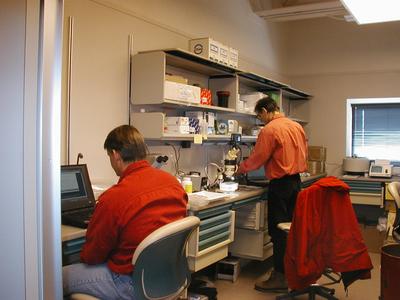
Dr. Jan Pawlowski (microscope) and Dr. Steve Alexander (computer) are diligently working in the Crary Lab at the McMurdo Research Station.

Dr. Sergei Korsun is working at his microscope in the Crary Lab. The focus of our research is to study the "Seasonal Dynamics of Giant Agglutinated Foraminifera" (forams). Dr. Korsun, who currently lives in St. Petersburg, Russia, lived in the Arctic for 14 years. His Arctic study of forams (one-celled organisms classified as protists) will be an interesting comparison to the forams in Antarctica.
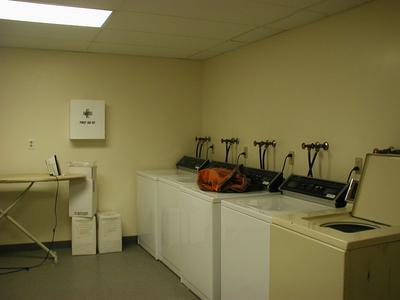
The laundry facilities at McMurdo Research Station are a welcome amenity, especially for the people coming in from the field.
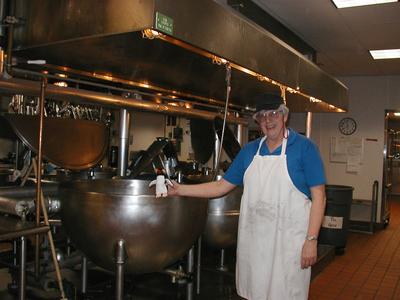
Myrna Gary and I corresponded before coming to Antarctica. I brought a "geo-bear" from Betty Trummel's fourth grade students in Crystal Lake, Illinois. (Betty is a 1998 TEA, whose journal entries may be found at http:// tea.rice.edu). Myrna will be taking the little bear on her journey before sending it back to the students. Myrna gave me a tour of the galley (kitchen/dining facililty) at McMurdo. She works the "mid-rat" shift, which serves rations or food to the midnight shift. This midnight hour is considered "lunch" to the people who work at night and sleep during the day. (It's hard to differentiate between night and day in Antarctica during the austral spring and summer because the sun never sets. At this time of year it is daylight 24-hours a day.) Myrna is giving "Spike" and me a tour of the kitchen while I'm waiting on my laundry to finish its cycle. The vats or pots hold huge quantities in order to feed the vast number of people who come through on any given day. McMurdo research station, not only houses people living and working at McMurdo, but also people in transport to and from the South Pole, or living in field camps. McMurdo is also the hub for travel, which houses people and cargo before being shuttled to outlying areas by way of military cargo planes, such as the LC 130 (equipped with skiis), helicopters, and Twin Otters (small planes). During my short stays in McMurdo, I live in a dorm-type room on the second floor. The first floor contains the galley for the research station, gift shop, computer room, recreation area, newspaper and media center, and the laundry room. I have been fortunate to stay in "Building 155", which has proven to be a convenient place to live while in McMurdo.

Osvaldo Torres and I flew to Antarctica together from Christchurch, New Zealand, on the C-141. He is working as a cook in the galley. While in Antarctica, he will continue to work on his masters degree in geography from New Mexico State University. Osvaldo is originally from Puerto Rico, but upon graduation, he hopes to get a job working with urban development in Mexico. He is currently taking graduate school classes online, in the midst of working and living in Antarctica. He plans to "winter-over" in Antarctica before returning home next October.
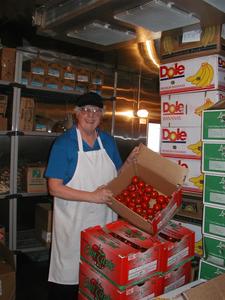
Although fresh fruits and vegetables are not plentiful in Antarctica, they are appreciated when they do arrive by plane from New Zealand. Myrna and I stopped to admire the bright red tomatoes and the bananas. As well as working the midnight shift, part of Myrna's job description is to make sandwiches and get lunches ready for any field party outings, survival trainings, or for flights out of McMurdo, especially flights going to the South Pole.
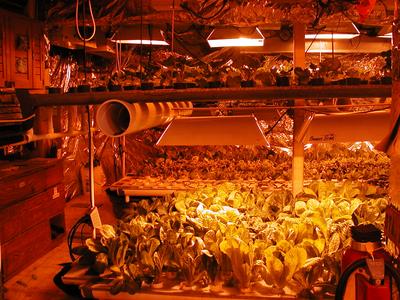
The "greenhouse" at McMurdo also supplies some fresh fruits and vegetables. The flowers and greenery inside this warm shelter add a splash of color to the surrounding whiteness.

In the galley, food islands are set up "buffet style" to accommodate the number of people who come through the galley at meal time. Dinner is anytime between 5 p.m. and 7 p.m.

The galley serves hundreds of people at a time. The cooks must use what they have on-hand, but it's surprising how well they improvise. We have been served fish, chicken, spaghetti, soup, baked breads, desserts, sub sandwiches, and frozen vegetables. At times, we have been fortunate to have salads, fresh fruit, and even icecream with toppings. Coffee, tea, hot chocolate, milk, cereal, and fruit juice are also available other than meal times.
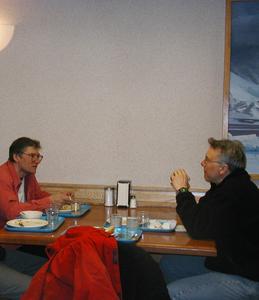
Dr. Jan Pawlowski (on the left) and Dr. Sam Bowser are discussing our research project over dinner. The dining room is a wonderful place to discuss science research, plan upcoming excursions, or future projects. Meeting in a relaxed atmosphere enable scientists, and the people who support science, a time to reflect, brainstorm, and share ideas.
Contact the TEA in the field at
.
If you cannot connect through your browser, copy the
TEA's e-mail address in the "To:" line of
your favorite e-mail package.
|
